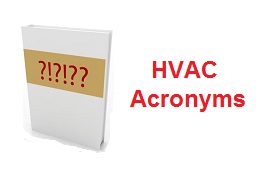Buying new HVAC equipment can be a daunting prospect. Not only do you need to find equipment that is the right size for your home and within your budget, but you also need to navigate through a vast range of unfamiliar terms and acronyms. Fortunately, you don’t need to take a HVAC language class at the local college as we can help guide you through this unfamiliar territory.
SEER:
All heat pumps and air conditioners have a Seasonal Energy Efficiency Ratio or SEER. This rating is used to determine the cooling efficiency of the equipment across the typical conditions of an average cooling season. All new equipment which is sold in America must have a minimum 13 SEER rating, but if you are looking for maximum energy efficiency, you should look for a product which has up to a 20 SEER rating.
EER:
While SEER is a determination of the performance across a range of temperatures, the Energy Efficiency Ratio is designed to be a purer form of measurement. This rating is calculated using a basis of a 95 degree outside temperature. The equipment is rated based on how efficient it would perform on this type of swelteringly hot day. Since air conditioners are only required by law to carry a SEER rating, you may struggle to find an EER rating on new equipment.
MERV:
When you are looking at filtration options for your new equipment, you are likely to come across the Minimum Efficiency Reporting Value or MERV. This rating is a measurement of how effective the filter is at capturing particles. A MERV rating of 13 to 16 can remove as much as 75 percent of airborne particles 0.3 microns or larger. This means that these filters are considered high ranking and are often recommended by manufacturers.
HSPF:
Heating Seasonal Performance Factor is used to demonstrate a heat pump efficiency when it is operating in heating mode. New heat pumps are mandated to be rated at least 7.7 HSPF, but if you want to enjoy significant savings, it is possible to get heat pumps which are rated at up to 13 HSPF.
AFUE:
If you want to see how much of the fuel used is actually turned into heat, you will find the Annual Fuel Utilization Efficiency rate interesting. This rating is expressed as a percentage to show how much fuel is transformed into heat. The higher the rating, the greater the efficiency. There are gas furnaces available on the market which have an AFUE rating of 98.5, which means only 1.5% of the fuel is wasted.
COP:
When determining efficiency in a geothermal heat pump, you need to look to the Coefficient of Performance rating. This is used to measure the relationship between the energy consumed and produced by the system. A higher rating indicates that this balance is not disproportionate and it offers good efficiency.
When shopping for heating or air conditioning equipment, it can be very easy to become overwhelmed by the terminology. Before you make a your final purchase decision, you should check your existing equipment is compatible and in good condition. A professional HVAC specialist can assess your system to ensure that you can enjoy the maximum possible energy efficiency.
